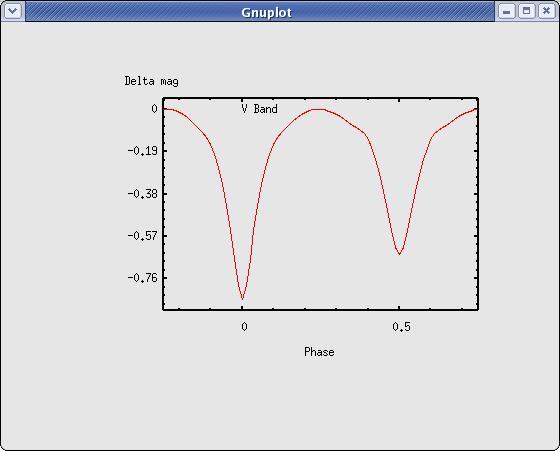

Light Curve Synthesis Program
Version : 1.32
Author(s) : Rainer Wichmann (rwichman@lsw.uni-heidelberg.de)
License : GPL
Website : http://www.lsw.uni-heidelberg.de/~rwichman/Nightfall.html
Installs from Open Source Astronomy for Linux cd 1
Disk space required for installation is 1.01 Mb
After the package is installed it can be accessed using the command
/opt/astro/bin/startnightfall
A shortcut will be installed in the KDE/GNOME desktop menu system,
as an entry in the Astronomy submenu

animated views of eclipsing binary stars, lightcurves and radial velocity curves, best-fit binary star parameters for a given set of observational data.
It is, however, not able to fry your breakfast egg on your harddisk.
Eclipsing binary stars are most often very close systems. In such systems, owing to tidal forces, the shapes of both stars can be highly nonspherical, up to the possible formation of an 'overcontact' system, where both stars form a single, dumbell-shaped object.
NIGHTFALL is a mildly ultramundane program of baroque complexity (I like Verdi and Händel on lazy sunday mornings - friday evenings are better with Iron Maiden and a good whisky). NIGHTFALL is based on a physical model that takes into account the nonspherical shape of stars in close binary systems, as well as mutual irradiance of both stars, and a number of additional physical effects.
NIGHTFALL can handle a large range of configurations, including overcontact systems, eccentric (non-circular) orbits, surface spots and asynchroneous rotations (stars rotating slower or faster than the orbital period), and the possible presence of a third star in the system.
NIGHTFALL supports the GNOME desktop (if installed), but does not require it. Also, NIGHTFALL supports internationalization. Currently, besides the default language (english), only german is supported. The language is selected by the environment variable LANG (must be set before starting the program, in sh, bash: LANG=de; export LANG in csh, tcsh: setenv LANG de). If used in non-interactive mode, unless a configuration file is read in at startup (see info on configuration files), NIGHTFALL requires at least the following six numerical arguments on the command line (in that order):
(1) the mass ratio of both stars (mass(Secondary)/mass(Primary), allowed range 0.0001 - 10000.0. For Roche lobe fill factors (see below) above one, the mass ratio is restricted to 0.003 - 50. (2) orbital inclination ( = viewing angle of orbital plane, range 0 - 90 degree), where 0 deg corresponds to face-on view (no eclipse possible), and 90 deg to edge-on view (eclipse guaranteed). For angles in between, the occurence of an eclipse depends on the mass ratio and the Roche fill factors (see below). (3,4) Roche lobe fill factors. The Roche lobe is the maximum volume a star can fill in a binary system. Its size is, in general, different for the two stars, and depends on the mass ratio (see details on 'Roche lobe' for an explanation). The Roche lobe fill factor is in units of the polar radius of the Roche lobe. The allowed range is 0.001 - 1.3. For values above 1.0, both stars merge into a common envelope/overcontact system. (5,6) surface temperatures of both stars (in Kelvin, range 350 - 350000; Kelvin = degree Celsius + 273.15). Just for comparison, the surface temperature of the sun is 5780 K. If you use the 'model atmosphere' option, the allowed range shrinks to 3000 - 35000K.
These six numerical arguments are always required, if NIGHTFALL is used in command-line (i.e. non-interactive) mode without reading in a configuration file (see below)
$ nightfall -U -C ty_boo.cfg
will read parameters from a configuration file and start NIGHTFALL in interactive mode. The configuration file is a simple text file that can be edited by hand. In interactive mode, you can also write out the current parameters to a configuration file.
$ nightfall (without arguments) will produce a full list of options (many).
By default, NIGHTFALL will do nothing more than run in non-interactive mode, compute the lightcurve, write it to an output file 'NightfallCurve.dat', and exit silently. If you want more (nifty plots, etc.), read on.